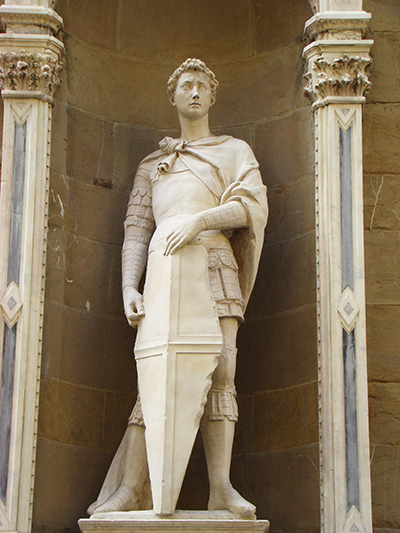Donatello's Orsanmichele second of fourteen statues of protectors of the arts of Florence is not only a treasure but also a gem that has been significant in art over the years.
To say that this statue is a masterpiece would be an understatement as different art pundits have praised the masterpiece since it's completion. Tasked to create the marble sculpture around 1413, Donatello beautifully carved the statue, and it was placed next to Saint Mark on a recess of the church in Orsanmichele.
St. George is perhaps the most famous of all Donatello's pieces. This is due to its design, importance in the history of Italians and youthful touch it possesses.
Donatello the Sculptor
Donatello was skilled, and could easily express emotions, feelings, and moods in his art. All of his sculptures tell a story. Born Donato di Niccolò di Betto Bardi in 1386, the Italian sculptor has over ten famous art pieces to his name.
His other works include Prophet Habakkuk, Virgin and Child with Four Angels, The Feast of Herod and Magdalene Penitent. Saint George by Donatello stands at the height of 209 cm. The sculptor's works led to his fame, and his links with the de Medicis family grew tight. He lived on carving sculptures at the whim of Cosimo, which was the family patriarch. Donatello kept working on his art until his demise in 1446.
The Saint George Statue
The statue has robust features, which show the masculinity and strong elements in the sculpture. The youthful nature of the icon makes it an interesting piece, as it displays an exquisite attribute. The statue was created as an honour to classical heroes of antiquity.
Its pose is riveting. Saint George by Donatello gives the impression of one pondering about self or having a moment of reflection. One can spot the uncertain expression on the face as it looks unsettled. His general look tells of a man who is unswervable and bold regardless of the situation.
The statue is a mixture of bronze cloth, leather, metal, hair, and flesh. Looking at it, one gets the impression of seeing different parts with real metal, flesh, hair, cloth, and leather, not just bronze plaster. Donatello was a genius, as he saw that having marble or bronze to carve the hair would make the hair appear real.
The Italian creative sculpted Saint George as he was believed to have been a few moments prior to him meeting and killing the dragon. The pose has in the past elicited debates and discussions as some academics think that the face of the statue looks confident and dauntless. His left arm is partly curled out to lie at the top of the shield in front of him.
For his garments, Donatello wears a plate skirt, a pair of boots, a chest cover, a cloak and a pair of gloves. His dressing is rather fascinating, considering he was about to confront the dragon. If you look keenly, you will realise that he appears to be holding something on his right hand.
One can speculate that it could be a lance in between the fingers. One can spot leather thongs around Saint George's shoulders and knees. This type of clothing could be analysed to pay homage to Rome.
The Reception
Being the talented sculptor, Donatello's work received appreciation and applause across Italy. Saint George by Donatello was a beautiful piece, and that is why it earned its place in the Orsanmichele church in Florence. The masses loved that it paid tribute to Roman heroism. The statue not being created with expensive bronze did not stop anyone from loving it.
Donatello's skills amused all, as one could feel realism in his piece of work. Thinking themselves as the heirs to the goddesses of the Roman empire, the Florentines cherished the tribute the statue brought. Guild members and every citizen present valued the statue.
Praise by Art Pundits
In the 16th century, Giorgio Vasari, an Italian painter, wrote the following about Saint George by Donatello;
Life itself seems to be stirring vigorously within the stone. And to be sure no modern statues have the vivacity and spirit produced by nature and art, through the hand of Donatello in this marble.
Another memorable quote was by Francesco Bocchi in the 16th century.
The legs move, the arms are ready, the head alert, and the whole figure acts; by virtue of the character, the manner and form of the action present to our eyes a valiant, invincible, and magnanimous soul.
Influence
In his imaginative mind, Donatello created a work of art that profoundly influenced the art of his peers in Florence. The youthful look made an excellent impression that any painting dedicated to a saint or junior warrior had some recollection of Saint George.
When creating the fresco of Pippo Spano of Legnaia, Andrea del Castagno, another Italian painter, referred to Saint George by Donatello for inspiration and guidance. Pippo Spano of Legnaia was a military commander from Florence who was viewed as an embodiment of fearlessness and boldness.
Mantegna's Eremitani fresco is almost a replica of Donatello's St. George. It is impressive how numerous artists admired Donatello's work that they went on copying his idea when creating their individual pieces. The marble copy of the head in the cortile of the Palazzo Quaratesi made by Brunelleschi between 1425 and 1430 is another proof that Saint George by Donatello was more than just a statue.
Celebrations of Saint George were held on different days during the year, and the statute was said to be the patron saint of the armoury. Humanist theories and antique art are some of the things that influenced Donatello. The Italian Renaissance sculptor will always be remembered for Saint George, as it revolutionised the art in Florence, Italy during the early Renaissance period. Saint George by Donatello is currently located at Bargello Museum in Florence. Donatello was indeed an icon.




